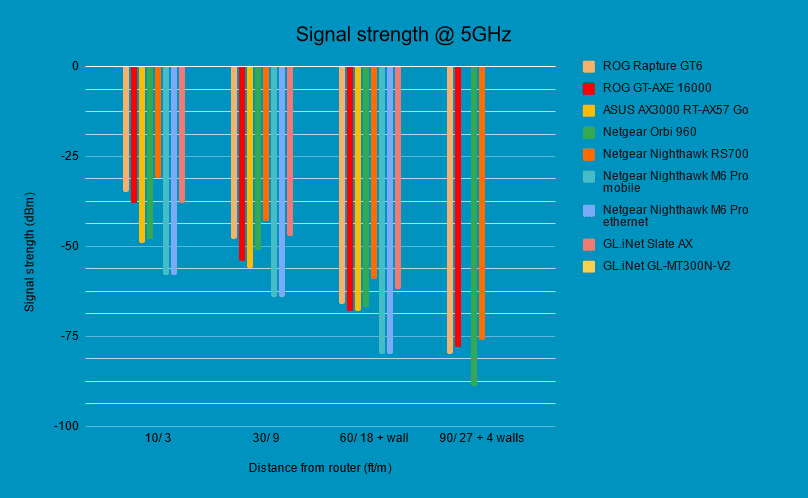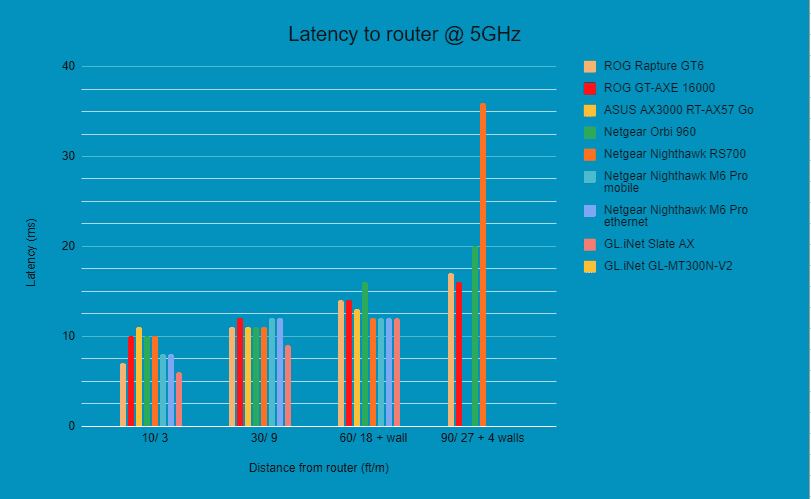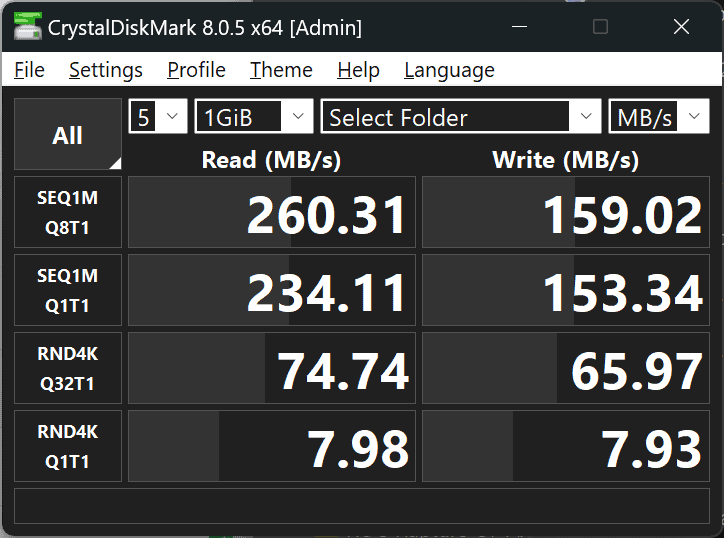
We tested and benchmarked the full Netgear Orbi RBKE963 setup, including RBRE960 host router and two RBSE960 satellites working in unison
Updated: Jun 12, 2024 1:16 pm
WePC is reader-supported. When you buy through links on our site, we may earn an affiliate commission. Prices subject to change. Learn more
The Netgear Nighthawk RS700 is a standalone router with WiFi 7 support and powerful wired options to boot, though it’s certainly not cheap. Still, buying this router should, in theory, keep your network setup future-proofed for a long time to come. Let’s see below how it measured up in our testing.

Specifications
- Wireless standard: WiFi 7
- Band Frequencies: 2.4GHz, 5GHz, 6GHz
- Max Speed: 19Gbps
- LAN Ports: 1x 10Gbps, 4x 1Gbps
- WAN: 1x 10Gbps (Router)
- CPU: Quad-core 2.6GHz
- Memory: 512MB NAND Flash and 2GB RAM
- USB: 1x USB 3.0 Type-A
- Dimensions: 281.7 x 124.0 x 142mm (11.1 x 4.9 x 5.6in)
- Weight: 1.635kg (3.61lb)
Show more
What We Think
The Nighthawk RS700 from Netgear is certainly not a router for everyone, given its exorbitant pricing for a single router unit, however this isn’t exactly atypical for WiFi 7 routers: if you want the latest standard, you’re going to have to pay a significant mark-up for it.
For your money though you get a strong performing router that will future-proof your setup for some time, with the 10Gbps WAN and LAN ports guaranteeing you won’t get bottlenecked with any future ultrafast fibre improvements. It’s good to see the inclusion of a USB-A 3.0 port, though we would have liked to have seen USB-C for this price.
The overall design of the router itself is quite nice and unobtrusive, and the dedicated app gives you plenty of control over how it is set up and what you can do with your network, although we could do without the constant subscription service adverts. All-in-all though, this is a powerful router if you’re willing to pay for it.
Pros
-
Simple and quick setup that guides through the app -
App control offers plenty of customization and changes but is also included on the web page -
Excellent performance across the board, including USB -
Good size that fits in many places including in design, plus can turn off blinking lights -
Future proof standards for WiFi, and 10Gbps WAN and LAN ports
Cons
-
Expensive for the US market, ridiculously so in the UK -
Annoying subscription adverts -
A USB-C port would have been nice
Pricing
In the US the Netgear Nighthawk RS700 has an MSRP of $699.99, which comes with a 1-year subscription to Netgear Armor cyber security. This is obviously not cheap, although it’s pretty typical of WiFi 7 routers with these sorts of specs at the time of writing.UK customers will have to pay substantially more though: a ridiculous £799.99 (the equivalent of around $1,000 at the time of writing) which frankly just isn’t worth it, no matter how well it performs: you could buy a renewed MacBook Air for the same price.
Overall Design
Previous
Next
The Nighthawk RS700 is quite a nice-looking device, if you’re into vaguely sci-fi looking tech. It resembles a tall (28.17cm/11.09”), all-black obelisk of an irregular hexagonal shape, with quite a relatively narrow (though stable) base of approx 4.9” across, meaning it thankfully takes up a minimum of desk space.
The front has all the status lights and buttons running down it in a single vertical strip, with the ports and sockets doing the same on the rear side. Heat vents are located on the top and bottom. Overall it’s pretty unobtrusive looking, and ideal for any office or home setup.
The quad-core 2.6Ghz processor, plus 2GB of RAM and 512MB of NAND Flash gives plenty of power and memory to manage multiple connections and allocate bandwidth.
The RS700 has contains 8 internal antennas, and is rated for a WiFi coverage of 3,500ft2, being able to connect to 200 different devices.
Frequency bands include one 2.4 GHz, 5 GHz, and 6 GHz, which can be connected to separately or merged together and connected to simultaneously through Multi-Link Operation, a feature unique to WiFi 7 routers, allowing the router to pick the fastest speed for your device from the combined selection of channels.
Wired connections include a 10Gpbs WAN (Wider Area Network) input for your ISP connection (well above the web package most people can get now, but it gives some nice futureproofing). More uncommonly you also get one 10Gbps LAN (Local Area Network), which means you can match the bandwidth coming into any of your devices connected to this via ethernet, which is very nice. In addition you get four more 1Gbps LAN ports (though two of these can be aggregated together to form a 2Gbps connection) and one USB 3.0 Type-A for a fast storage connection.
Other features
Additional features include the ability to set up a guest network with different permissions, which gives you that extra bit of network security: pretty typical for routers at this price point. The RS700 also comes with the ability to add a VPN to your entire network, which updates automatically for the latest security patches.
For added protection, you can use Netgear Armor with its smart parental controls, additional VPN and general protection against hackers, though this requires a paid-for subscription which is a bit irksome considering the asking price of the router in the first place.
The inbuilt application to control the router is pretty feature-rich on the whole, offering extensive controls and a straightforward interface. The requirement to sign in and register the router, which automatically starts your subscription trial and warranty, is a bit long winded (this applies to other Netgear routers we’ve tested). Finally, the app does come with frequent pop-ups advertising additional subscriptions and features, which is a bit irritating, but realistically you won’t need to use the app very often after the initial setup, so they’re manageable.
Performance
In our performance testing, we subjected the router to a variety of scenarios to evaluate its effectiveness. It should be noted that our testing environment was a bit more limited than is ideal: we only had WiFi 6 devices to test with (we opted for the Samsung S21 FE smartphone specifically), so our WiFi testing was limited to the 2.4 and 5GHz frequency bands. Additionally, the network was limited and throttled to around 300Mbps.
The wireless connection (between the router and the testing device i.e. the phone) was tested at the standard distances we always use: 10ft/3m (uninterrupted), 30ft/9m (uninterrupted), 60ft/18m (with a wall between the two devices), and finally 90ft/27m (with two walls between the devices).
Given there was no USB port on the router, we could not perform our standard file transfer speed test.
Signal strength and latency
In our testing, we evaluated a router’s effectiveness across a variety of standardised scenarios. It’s important to note however that our testing environment has certain limitations: we only have WiFi 6 devices available, specifically the Samsung S21 FE smartphone, so our WiFi testing was confined to the 2.4 and 5GHz frequency bands. Additionally, the web connection is limited and throttles at around the 300Mbps mark.
We tested the wireless connection between the router and the phone at our standard distances: 10ft/3m (uninterrupted), 30ft/9m (uninterrupted), 60ft/18m (with one wall in between), and 90ft/27m (with two walls in between).
Finally, we conduct a file transfer test by connecting an SSD to the USB port on the router, then transferring a file to and from it with a PC connected to the router’s ethernet port.
Signal strength basically measures the reliability of the connection, and is measured in dBm (decibel milliwatts). The scale of results typically measures between -30dBm and -90dBm, with the former being considered the ‘ideal’ result, and disconnection typically occurring at around -90dBm. The main factor governing signal strength (besides external interference) is typically the quality/power of the antenna on the router.
In this test the RS700 scored strongly, particularly within the 5GHz band, where it bested every other router we’ve bested so far. At 2.4GHz results ranged from -41dBm to -62dBm up to 60ft (with loss of signal at 90ft), with the 5GHz results ranging from -31dBM to -76dBm (including those readings taken at 90ft). The RS700 advertises a coverage of 3,500 sq. ft., which would be approximately the 60ft test, though it does reach beyond this on the 5Ghz frequency as we can see.
Previous
Next
Previous
Next
Latency is measured in milliseconds (ms), and represents how long it takes for data to travel between the router and the device, with the lower values obviously being quicker. Latency ranged between 13-20ms in the 2.4GHz band across the first three distances (with loss of connection at 90ft). In the 5GHz band, latency ranged between 11-23ms at the first three distances, jumping to 36ms at the 90ft range.
Previous
Next
Previous
Next
Regarding the speed test, we conducted several tests to evaluate internet speed, including the physical connection speed between the phone and router, and a WiFi speed test to assess how signal strength impacts performance.
Network download speed was measured by the Oopla speed test app in Mbps (Megabits per second). Measured at the 10/30/60/90ft distances, the 2.4GHz averaged at 103/78.4/5.6/0Mbps respectively, with upload speeds of 62/50/22/0Mbps. 5Ghz attained average downloads of 273/269/117/25.5Mbps and uploads of 239/227/131/8Mbps. On LAN, the RS700 achieved a download speed of 262Mbps and an upload speed of 254Mbps, which doesn’t sound a lot given the maximum 10Gbps LAN limit, however considering the limitations of our internet this was still a solid result.
Previous
Next
Physical download/upload speed is measured via the WiFiman app, also in Mbps. Measured at the 10/30/60/90ft distances, the 2.4GHz band had a 206/206/137/0Mbps download strength, with an upload of 286/258/149/0Mbps respectively. The 5GHz channel achieved 1200/864/288/8Mbps download and 1080/1080/576/17Mbps upload speeds respectively.
Previous
Next
File transfer test
For our final test, we benchmarked the read and write speeds when transferring files between a PC connected to the router via a LAN port, and an SSD (in a USB adapter sled) connected to the router via the USB port.
Using the CrystalDiskMark tool, we saw the router achieve a 260MB/s read and 159MB/s write speed in the first sequential test (with 8 queues and 1 thread) – this is when the files are arranged linearly and so is always the quickest test of the bunch. In the first random test this dropped to 75MB/s for the read and 66MB/s for the write in the 32 queue and 1 thread test, with the 1 queue 1 thread being even slower.
As you can see in the bar graph image, out of all the routers we’ve tested so far, the RS700 was the fastest option, particularly when it comes to write speed.
Previous
Next
Previous
Next














